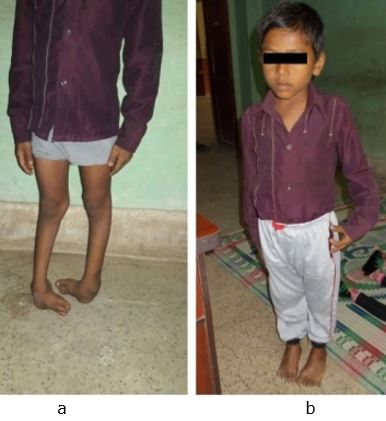Ponseti Technique In Children With Idiopathic Club Foot Presenting After 1 Year Of Age: A Retrospective Study
Abstract
Background: Ponseti method is accepted as gold standard treatment for idiopathic clubfoot in infants. However, very few studies are available in literature on use of Ponseti method in older children. The aim of this study is to determine the effectiveness of Ponseti technique in the treatment of late presenting congenital idiopathic club foot (CTEV).
Material & Methods: We retrospectively evaluated the results of ponseti method of serial casting in 23 patients with 32 clubfeet (15 males and 8 females) presenting after the walking age by using Pirani score. Quantitative variables were expressed as mean ± standard deviation and compared between initial and last follow-up scores using the paired t-test.
Results: The mean age at presentation was 3.4 (range 1 to 15) years and mean follow up was 14.2 (range 6 to 21) months. The mean pre-correction Pirani score improved from 4.51 (range 2.5 to 6) to 0.55 (range 0 to 1) after treatment, respectively which was statistically significant (p < .001). In 95% of the feet, satisfactory correction of the deformity was achieved. The mean number of casts applied was 9.2 (range 6 to 16).
Conclusion: The Ponseti technique is an effective method for the management of idiopathic clubfoot, even in older children up to 15 years of age.
Downloads
References
2. Ponseti IV, editor. Treatment. In: Congenital Clubfoot: Fundamentals of Treatment. 1st ed. Oxford: Oxford University Press; 1996. pp 61-97.
3. Morcuende JA. Congenital idiopathic clubfoot: prevention of late deformity and disability by conservative treatment with the Ponseti technique. Pediatr Ann. 2009;35(2):128-32.
4. Pirani S, Maddumba E, Mathias R, Kone-Lule J, Penny JN, Beyeza T, Mbonye B, Amone J, Franceschi F. Towards effective Ponseti clubfoot care: the Uganda sustainable clubfoot care project. Clin Orthop Relat Res. 2009;467:1154–63.
5. Penny JN. The neglected clubfoot. Tech Orthop. 2005;20:153-66.
6. Lourenço AF, Morcuende JA. Correction of neglected idiopathic club foot by the Ponseti method. J Bone Joint Surg Br. 2007;89:378-81.
7. Verma A, Mehtani A, Sural S, Maini L, Gautam VK, Basran SS, et al. Management of idiopathic clubfoot in toddlers by Ponseti's method. J Pediatr Orthop Br. 2012;21:79-84.
8. Khan SA, Kumar A. Ponseti's manipulation in neglected clubfoot in children more than 7 years of age: A prospective evaluation of 25 feet with long term follow up. J Pediatr Orthop Br. 2010;19:385-9.
9. Spiegel DA, Shrestha OP, Sitoula P, Rajbhandary T, Bijukachhe B, Banskota AK. Ponseti method for untreated idiopathic clubfeet in Nepalese patients from 1 to 6 years of age. Clin Orthop Relat Res. 2009;467:1164-70.
10. Pirani S, Outerbridge H, Moran M, Sawatsky BJ. A method of evaluating the virgin clubfoot with substantial inter-observer reliability Miami, Florida: POSNA; 1995; 71:pp 99.
11. Aronson J, Puskarich CL. Deformity and disability from treated clubfoot. J Pediatr Orthop. 1990;10:109-19.
12. Morcuende JA, Dolan LA, Dietz FR, Ponseti IV. Radical reduction in the rate of extensive corrective surgery for clubfoot by using the Ponseti method. Pediatrics. 2004;113:376-80.
13. Dobbs MB, Nunley R, Schoenecker PL. Long-term follow up of patients with clubfeet treated with extensive soft-tissue release. J Bone Joint Surg Am. 2006;88:986-96.
14. Ippolito E, Farsetti P, Caterini R, Tudisco C. Long term comparative results in patients with congenital clubfoot treated with two different protocols. J Bone Joint Surg Am. 2003;85:1286-94.
15. Ponseti IV. Treatment of congenital club foot. J Bone Joint Surg Am. 1992;74:448-54.
16. Sinha A, Mehtani A, Sud A, Vijay V, Kumar N, Prakash J. Evaluation of Ponseti method in neglected clubfoot. Indian J Orthop. 2016;50:529-35.

The entire contents of the Orthopaedic Journal of Madhya Pradesh Chapter are protected under Indian and International copyrights. Orthopaedic Journal of Madhya Pradesh Chapter allow authors to retain the copyrights of their papers without restrictions, Authors grant the publisher the right of exclusive publication. The Journal then grants to all users a free, irrevocable, worldwide, perpetual right of access to, and a license to copy, use, distribute, perform and display the work publicly and to make and distribute derivative works in any digital medium for any reasonable non-commercial purpose, subject to proper attribution of authorship. The journal also grants the right to make numbers of printed copies for their personal non-commercial use under Creative Commons Attribution-Non-commercial share alike 4.0 International Public License.

 OAI - Open Archives Initiative
OAI - Open Archives Initiative












